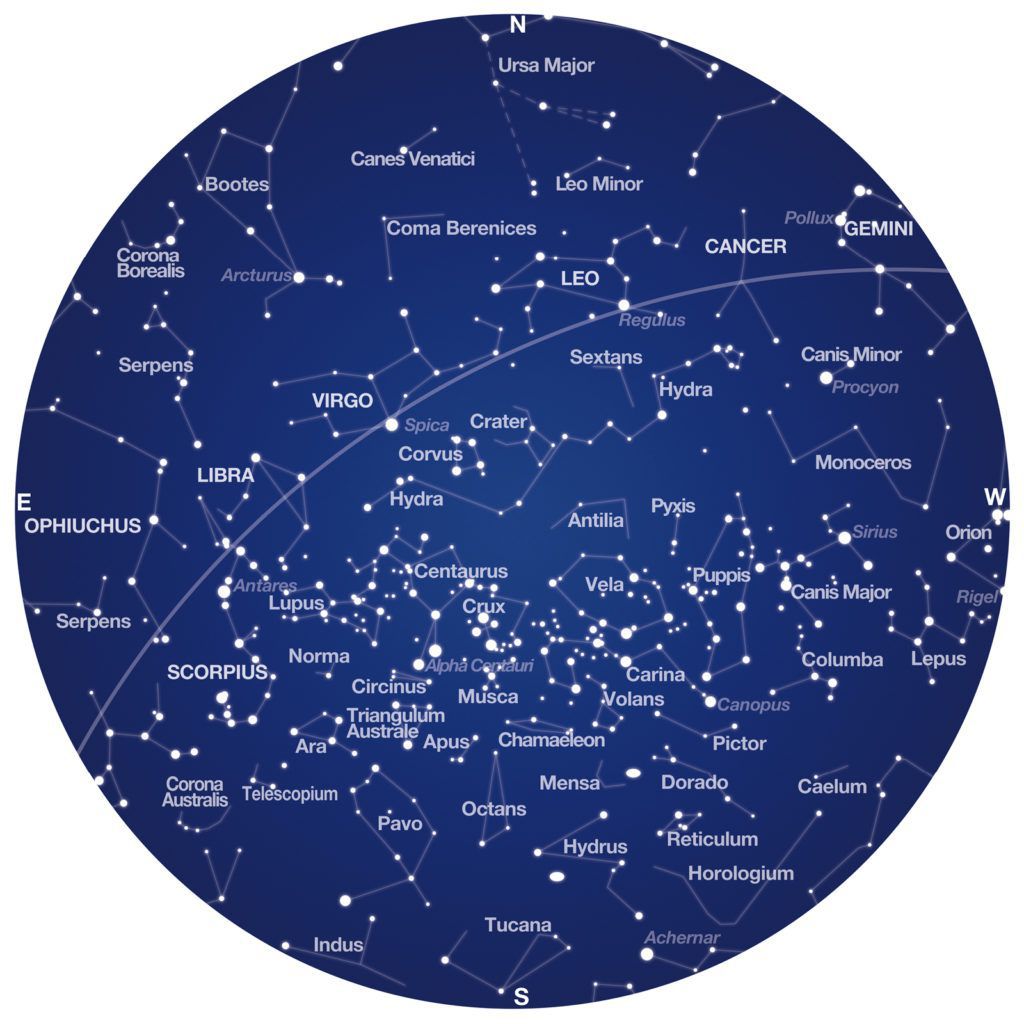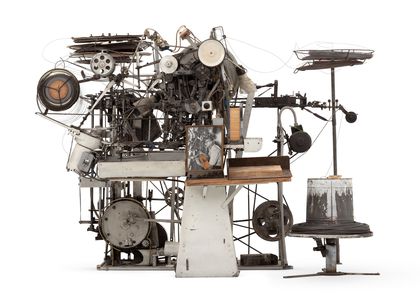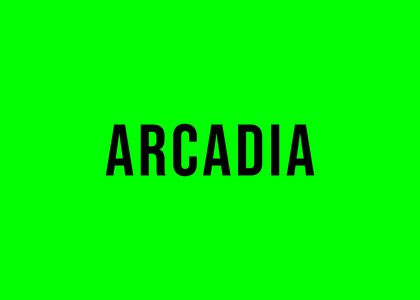
Monthly sky maps from the 2022 Australasian Sky Guide published by MAAS Media.
What’s in the sky this June?
Constellations
Constellations represent groups of stars that have been given a name and more recently a border. For millennia they have been used as a tool to share significant cultural stories, events and as markers. Today, the 88 western constellations used here help astronomers map the sky and search for astronomical objects. This June these constellations dominate the winter sky:
- Leo – the lion, in the northwest, looks more like an upside-down question mark, as seen in the southern hemisphere, than a lion from the north. Its brightest star Regulus (Little King) is a system of four tightly bound stars at 79 light years. It was once referred to as one of the four Royal Stars, or guardians of the heavens because of its proximity to the point in the sky that marked the northern Summer Solstice as seen by Persian astronomers ~5,000 years ago. Precession of the equinoxes has now moved this point to Cancer the crab.
- Virgo – the maiden, high overhead is the second largest constellation in the sky and one of the two in which the ecliptic and celestial equator cross. This one marks the current position of the September equinox, the beginning of our Spring. It is home to a cluster of galaxies of which M87 is the largest at around 60 million light years with a central black hole at least 7 billion times the mass of the Sun. It has one bright star, the 16th brightest in the night sky, Spica which is about 250 light years away. Like most stars, it is a binary. The brighter being about 7 times the diameter of the Sun and 10 times more massive. Its hot surface temperature of around 20,000 kelvin makes it blue-white in colour.
- Scorpius – high in the eastern sky, is one of the brightest and most easily identifiable constellations with its hooked tail, heart represented by the red supergiant star Antares and three stars of the head and claws. In Greek Mythology, the scorpion plays a role in many myths, however it is best known for its pursuit of Orion through the night sky.
- Sagittarius – also known as the archer, can be found 15 degrees, one outstretched hand span, to the east of Scorpius’s stinger. Sagittarius is home, as we see it, to the centre of our galaxy, the Milky Way with a monstrous black hole about four million times the mass of the Sun and 26,000 light years away. It is called Sagittarius A * (pronounced as Sagittarius A Star). Images taken in 2017 but released in May 2022 from NASA’s Event Horizon Telescope (EHT), show matter swirling around it at close to the speed of light. The event horizon is about the same distance from the singularity as Mercury is from our Sun.
- Libra – low in the east below Scorpius is the only non-living zodiac, Libra the scales. In the past Libra was part of Scorpius, forming the scorpion’s claws but has become synonymous with the scales of justice. The former association of Libra and Scorpius is reflected in the names of the two brightest stars in Libra – Zubenelgenubi and Zubeneschamali meaning the ‘southern claw’ and the ‘northern claw’ respectively.
- Crux – the Southern Cross, the smallest constellation and its pointers of Alpha and Beta Centauri are high in the south in the early evening. To find south, draw an imaginary line from the top of Crux though the bottom and across the sky. Midway between the Pointers draw a line perpendicular to the line that joins them. Where these two lines intersect is close to the southern celestial pole. From this point drop to the horizon for south.
- Centaurus – surrounding the Southern Cross on three sides is Centaurus, the Centaur, said to represent the scholarly Chiron, tutor of many of the Greek gods and heroes. The two bright stars Alpha and Beta Centauri, known as the Pointers, make up the front legs of the centaur. The brighter of the two, Alpha is the brightest star in the constellation and our Sun’s closest neighbour. It is a complex system of three stars.
- Carina – in the southwestern sky and represents the keel of a ship. Carina and the nearby constellations of Vela (the sails) and Puppis (the stern) were part of the huge constellation Argo Navis that in Greek mythology carried Jason and the Argonauts in search of the Golden Fleece of Aries the Ram. In 1756, Nicolas Louis de Lacaille published his catalogue of the southern stars showing Argo Navis divided into the three constellations we see today. Canopus, the second brightest star in the sky, can be found in Carina and is a white supergiant star about 313 light years away. Its low position at this time of year should make it twinkle through many colours.
- Bootes – the herdsman is low in the north and quite unremarkable save for the fourth brightest star in the night sky, and brightest in the north, Arcturus. It is only slightly more massive than our Sun but its advanced evolution has taken it off the Main Sequence and it is a bloated giant 25 times bigger and 170 times brighter which gives it a golden orange hue at a distance of about 37 light years.
Planets
- All 5 naked eye planets will be visible in the morning sky though Mercury will be the most challenging.
- Mercury is very low in the northeast ahead of sunrise. It will be in Taurus but will be hard to see. On 17 June it will be at its greatest angular distance or elongation from our Sun and on 27 June, the crescent Moon is just above to the north.
- Venus is in the northeast starting in Aries before wandering into Taurus with Mercury. On 26 June the old crescent Moon is above and to the north or left of Venus.
- Mars is also in the northeast spends most of the month in Pisces. On 23 June, the old crescent Moon is below and to the east or right of the planet. On the opposite side of our Sun, it is quite faint at magnitude m0.57 making it 10 times fainter than what it will be at Opposition in December.
- Jupiter is high in the north moving from Pisces to Cetus the whale. On 22 June the waning crescent Moon will be below and to the east or right. A small telescope should be able to resolve it 4 large Moons and two equatorial belts.
- Saturn is high in the northwest in the constellation of Capricornus and on 19 June the waning gibbous Moon will be above and to the north or right.
Moon
For the monthly movements of the Moon, check out our Moon Phase Calendar.
Deep Sky
Explore the universe through binoculars or a telescope and take in these gems of the June sky:
- NGC4755, Jewel Box Open Cluster – is about 6,400 light-years away within Crux or the Southern Cross. It contains about 100 young blue and red super giants less than 14million years old. Visible to the naked eye close to Beta Crucis it is best seen through a small telescope.
- Alpha Centauri star system – A star system consisting of three stars, Alpha Centauri A, Alpha Centauri B and the closest star to our Sun, Proxima Centauri at 4.2 light-years. Proxima Centauri is a red dwarf star and is only visible through large telescopes. It is believed to be orbiting the two larger stars. A small telescope will show the brighter pair as a close binary. They take about 80 years to orbit one another.
- NGC5139, Omega Centauri Globular Cluster – One of at least 150 globular clusters within the Milky Way. This is the largest within the galaxy and may be the core of an older dwarf galaxy. It is 17,000 light-years away and contains around 10 million stars within the Centaurus constellation. It is visible to naked eye away from cities and towns on a moonless night. Look to the front legs of the centaur as a guide.
- The Milky Way – as seen from dark rural locations on a moonless night is perfect at this time of year around midnight with the centre in Sagittarius high overhead. The faint glow of billions of stars extends from the low southwest across the sky to the northeast. No telescope is required and look for the head and neck of the emu in the sky.
- NGC3372, The Great Nebula in Carina – sinking into the southwest, is more than four times larger than the more famous Orion nebula (M42) seen in summer. Its distance of around 7,500 light years disguises its immense size of around 500 light years in diameter. On a moonless night it is a stunning view through binoculars or a telescope as well as being visible to the naked eye. It contains some of the youngest star clusters in the Milky Way as well as a star already coming to an explosive death. The star Eta Carinae at 100-150 times the mass of the Sun is a dying cataclysmic variable which is expected to explode as a supernova anytime within the next million years. A supernova precursor eruption in the 1840s temporarily elevated it to the second brightest star in the night sky.
- M104, the Sombrero Galaxy – is an almost edge on barred spiral galaxy about 30% the size of the Milky Way 28 million light years away. Its central black hole is about one billion times the mass of our Sun which makes it one of the largest black holes found so far in the heart of a galaxy. It is situated within the constellation Virgo on the border with Corvus. It requires a moderate sized telescope and will appear as a small smoky smudge.
Other events
- The Winter solstice is on Tuesday 21 June at 7:14pm AEST. This is the point in time when our Sun reaches its most northerly point in the sky in our yearly orbit and begins to head back toward the south. The annual north south movement of the Sun in the sky is the result of an impact by an object called Theia around 4.5 billion years ago. The collision led to the formation of the Moon and left the Earth tilted to one side by 23.5 degrees which is the reason for the season.
- Tau Herculid meteor shower. On 31 May and 1 June, there may be a meteor shower or perhaps a storm low in the northern sky near the constellations of Bootes and Hercules . It peaks on 1 June at 05:00 UT (3pm AEST) but our best chance is around 10pm to 1am. It is the result of the Earth passing through the dust trail left by Comet 73P/Schwassmann-Wachmann 3. While it peaked in May 1930, some suspect this year the Earth will move headlong into the debris trail left as the comet fragmented in 1995. If this is the case, those in the northern hemisphere may see a meteor storm of up to 1000 meteors per hour. Our view will be significantly poorer but worth the effort.
Learn More
- Purchase the 2022 Australasian Sky Guide by Dr Nick Lomb, featuring an annual report of what’s in the sky and the latest astronomical findings. Produced by MAAS Media.
- View the June Sky Chart, which shows the stars, constellations and planets visible in the night sky from anywhere in Australia
- Check out these resources for getting started.



Hello Janet,
Yes all 5 unaided eye planets will be visible on 24 June. They will be visible for the rest of the month too if you have a clear easterly view ahead of sunrise, though Mercury will be harder to see due to its later rising each day.
On 23 June the Moon will be close to Mars and close to Venus on 26 June. To make matters more interesting, the Moon will be close to Uranus on the morning of 25 June.
Geoff
Can you confirm that Mercury Venus moon Jupiter and Saturn will all be lined up in their order from the sun on 24 June this year. It’s listed as 4.21EDT. Would that be 6.21pm Sydney time or in the early morning on 24th